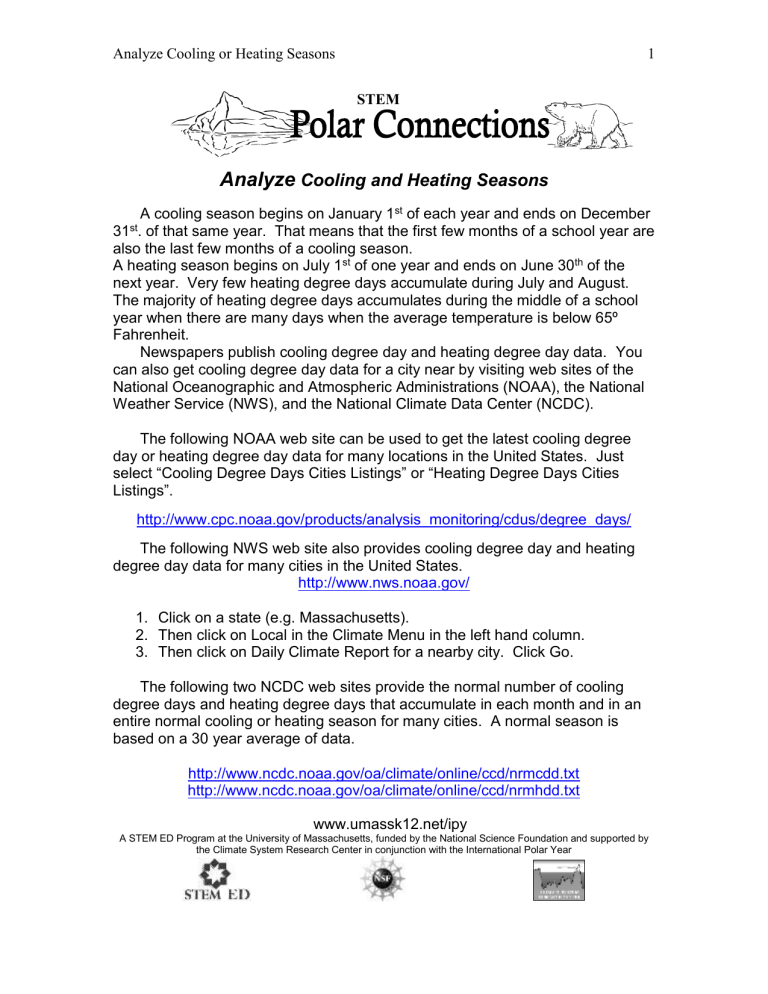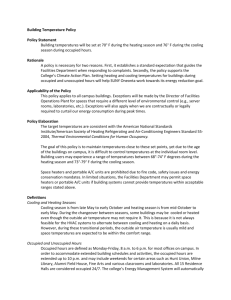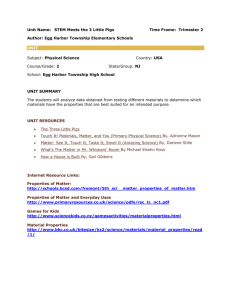Analyzing Cooling and Heating Seasons

Analyze Cooling or Heating Seasons 1
STEM
Analyze
Cooling and Heating Seasons
A cooling season begins on January 1 st of each year and ends on December
31 st . of that same year. That means that the first few months of a school year are also the last few months of a cooling season.
A heating season begins on July 1 st of one year and ends on June 30 th of the next year. Very few heating degree days accumulate during July and August.
The majority of heating degree days accumulates during the middle of a school year when there ar e many days when the average temperature is below 65º
Fahrenheit.
Newspapers publish cooling degree day and heating degree day data. You can also get cooling degree day data for a city near by visiting web sites of the
National Oceanographic and Atmospheric Administrations (NOAA), the National
Weather Service (NWS), and the National Climate Data Center (NCDC).
The following NOAA web site can be used to get the latest cooling degree day or heating degree day data for many locations in the United States. Just select “Cooling Degree Days Cities Listings” or “Heating Degree Days Cities
Listings”. http://www.cpc.noaa.gov/products/analysis_monitoring/cdus/degree_days/
The following NWS web site also provides cooling degree day and heating degree day data for many cities in the United States. http://www.nws.noaa.gov/
1. Click on a state (e.g. Massachusetts).
2. Then click on Local in the Climate Menu in the left hand column.
3. Then click on Daily Climate Report for a nearby city. Click Go.
The following two NCDC web sites provide the normal number of cooling degree days and heating degree days that accumulate in each month and in an entire normal cooling or heating season for many cities. A normal season is based on a 30 year average of data. http://www.ncdc.noaa.gov/oa/climate/online/ccd/nrmcdd.txt
http://www.ncdc.noaa.gov/oa/climate/online/ccd/nrmhdd.txt
www.umassk12.net/ipy
A STEM ED Program at the University of Massachusetts, funded by the National Science Foundation and supported by the Climate System Research Center in conjunction with the International Polar Year
Analyze Cooling or Heating Seasons 2
Developing a Strategy for Analyzing Cooling Seasons or Heating Seasons
A Sample Analysis of a Cooling Season
Data Table #1: Sample Cooling Degree Day Data
Yesterday
So far this month
11
121
So far this cooling season (since January 1st) 605
So far in an average cooling season (a 30 year average) 561
_x _ = ___CDD so far this cooling season_____
100 CDD so far in an average cooling season x % = _ ____CDD so far this cooling season___ x 100
CDD so far in an average cooling season
Cooling degree data from Data Table #1 can be entered into the formula.
x % = ____605 CDD so far this cooling season____ x 100
561 CDD so far in an average cooling season x% = 1.078 x 100 = 107.8%
The cooling season represented in Data Table #1 is 7.8% warmer than an average cooling season for the date that the data was collected.
There are Many Ways to Analyze a Cooling Season or Heating Season.
How does the present cooling or heating season compare with the previous cooling or heating season?
How does the present cooling or heating season compare with an average cooling or heating season?
How many cooling or heating degree days accumulate in a cooling or heating season where you live?
How many more cooling or heating degree days will probably accumulate during the remainder of the cooling or heating season where you live?
What percentage of cooling or heating degree days remain to accumulate in the cooling or heating season where you live?
How does a cooling or heating season where you live compare with cooling or heating seasons in other parts of the country?
How does a cooling or heating season where you live compare with cooling or heating seasons in other countries?



